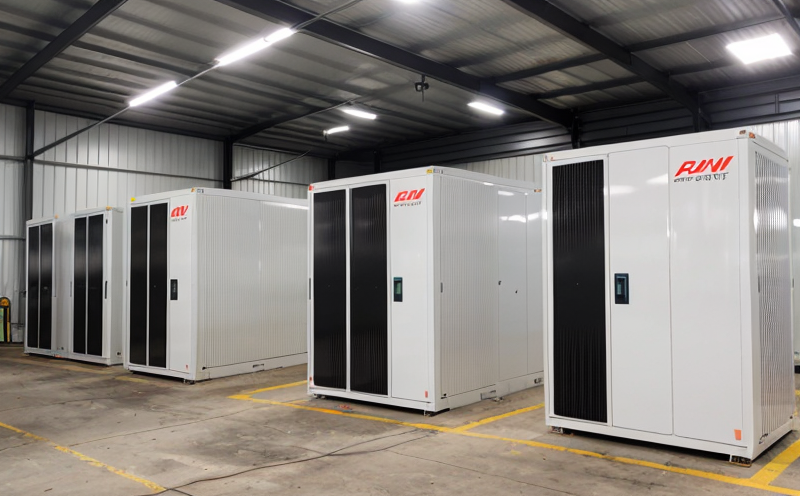ASTM D5276 Drop Testing of Battery Transport Systems
The ASTM D5276 standard provides a comprehensive framework to evaluate the durability and safety of battery transport systems. This testing procedure is critical for ensuring that these systems can withstand the rigors of transportation without compromising performance or risking damage to batteries or surrounding components.
Drop tests are designed to simulate real-world conditions where batteries may experience impacts during loading, unloading, and transit. These tests help manufacturers identify potential weaknesses in their designs early in the development process, allowing for necessary modifications before products reach the market. The test procedure outlined in ASTM D5276 is widely recognized within the industry as a key method to ensure compliance with international safety standards.
The testing process involves subjecting battery transport systems to controlled drops from various heights onto different surfaces. The height and surface type are chosen based on factors such as expected environmental conditions, packaging methods, and typical handling procedures. For instance, if a battery is likely to be transported in a container that will be lifted by forklifts, the test may involve dropping the package from a height of 1 meter onto concrete or steel plates.
Specimens used in these tests are typically full-scale transport units containing batteries and associated components. Preparing specimens involves ensuring they represent actual shipping configurations as closely as possible. This includes correct placement of batteries within their respective enclosures, securing all fasteners, and applying any protective coatings that would be used during regular transportation.
Instrumentation plays a crucial role in ASTM D5276 testing. High-precision impact testers are employed to ensure consistent application of force throughout each drop test. Sensors embedded in the test setup measure critical parameters like peak acceleration, velocity, and time duration of contact between the specimen and the surface upon impact.
The acceptance criteria for passing this test vary depending on the specific requirements set by individual clients or regulatory bodies. Generally speaking, a successful outcome means that no visible damage occurs to either the battery itself or its containment structure after being subjected to multiple drop cycles according to specified protocol. Additionally, any functional tests conducted post-test should yield results consistent with pre-test levels.
Real-world applications of ASTM D5276 testing extend beyond mere compliance; they also serve educational purposes by demonstrating best practices for safe handling and storage of lithium-ion batteries. By participating in such evaluations early on during product development cycles, manufacturers can anticipate issues before they become costly problems later down the line.
Implementing ASTM D5276 ensures that battery transport systems are robust enough to face real-world challenges without compromising safety or efficiency. This standard contributes significantly towards building trust among consumers who rely heavily upon portable electronic devices powered by lithium-ion batteries.
- State-of-the-art facilities equipped with advanced drop test equipment capable of replicating diverse transport scenarios.
- A team of experienced engineers specializing in energy and renewable testing who understand the nuances involved in ASTM D5276 compliance.
- Comprehensive support services including consultation on optimal specimen preparation techniques tailored specifically for your product design.
- Prompt turnaround times ensuring timely completion even under tight deadlines without compromising quality standards.
At Eurolab, we pride ourselves not just in meeting but exceeding expectations set forth by ASTM D5276. Our commitment to excellence translates into reliable data that can be confidently used during regulatory submissions or internal R&D projects.
- Enhanced product reliability leading to increased customer satisfaction through superior performance in challenging transport conditions.
- Reduced risk of recalls due to failures caused by improper handling during transit stages, thereby protecting brand reputation.
- Faster time-to-market thanks to early identification and rectification of design flaws discovered via ASTM D5276 testing.
Our clients appreciate the detailed reports generated from our ASTM D5276 tests which not only document results but also provide valuable insights into areas needing improvement. These reports serve as crucial tools during post-mortem analyses and future iterations of product designs.
- Establishes a benchmark for quality that competitors strive to match or surpass, giving you an edge in the market.
- Increases confidence among investors looking at sustainability practices within your organization, potentially attracting more capital investment.
- Fosters stronger relationships with suppliers and customers alike by demonstrating commitment to high standards of safety and efficiency.
By incorporating ASTM D5276 into your quality assurance protocols, you position yourself as a leader in the energy sector. Such leadership can significantly influence market trends favorably towards safer, more efficient battery transport solutions.





